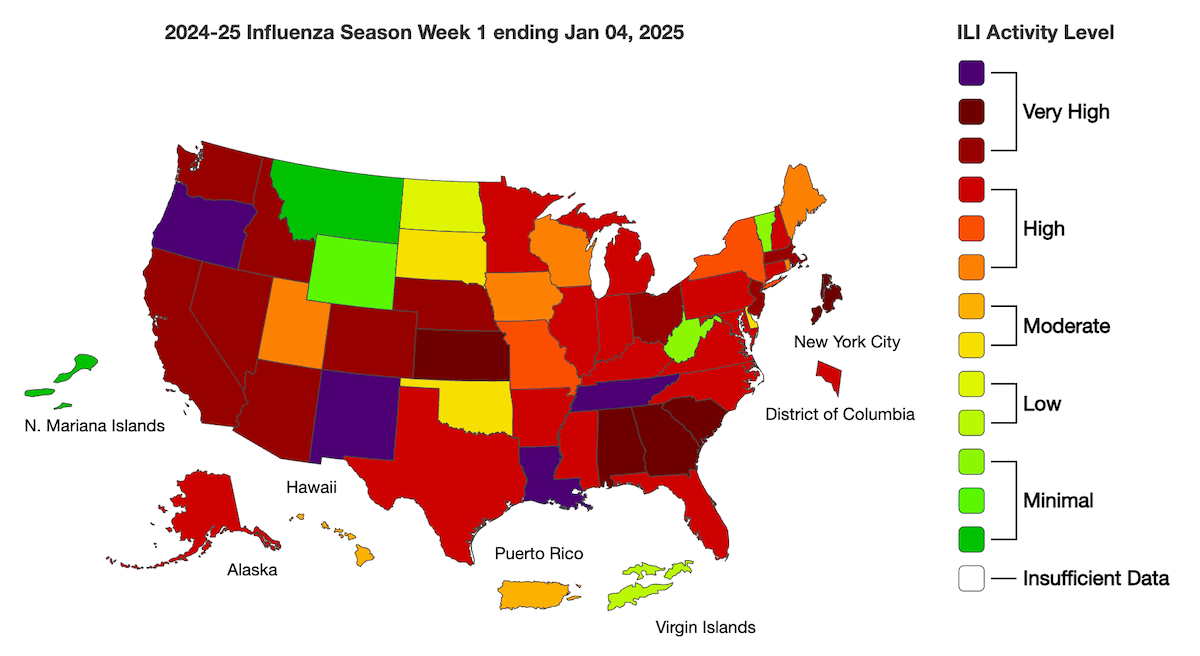Flu Levels Are “Very High” and “High” in 41 States After Holiday Surge

If it feels like everyone around you is sick, that’s because they probably are. The true effects of holiday gatherings are coming to light, and it’s not pretty. COVID infections and COVID-related emergency room visits are spiking, partly due to the XEC variant doubling in strength since September. Norovirus, whooping cough, and RSV are also on the rise. And now the Centers for Disease Control and Prevention (CDC) confirms that the flu is just as, if not more, worrisome. For the week ending Jan. 4, the agency is reporting “very high” or “high” flu levels in all but nine states.
RELATED: COVID Levels are “Very High” and “High” in These 28 States After Holiday Surge.
Flu levels are “high” in 23 states.
The CDC’s Weekly Influenza Surveillance Report assigns each state a level, in order of severity: minimal, low, moderate, high, and very high. Within each category are two or three sub-levels of severity. Currently, the following 23 states have “high” flu levels:
- Alaska
- Arkansas
- Connecticut
- Florida
- Illinois
- Indiana
- Iowa
- Kentucky
- Maine
- Maryland
- Michigan
- Minnesota
- Mississippi
- Missouri
- New Hampshire
- New York (New York City is “very high”)
- North Carolina
- Pennsylvania
- Rhode Island
- Texas
- Utah
- Virginia
- Wisconsin
Flu levels are “very high” in 18 states.
- Alabama
- Arizona
- California
- Colorado
- Georgia
- Idaho
- Kansas
- Louisiana
- Massachusetts
- Nebraska
- Nevada
- New Jersey
- New Mexico
- Ohio
- Oregon
- South Carolina
- Tennessee
- Washington
- Washington, D.C.
RELATED: Doctors Say the Disinfecting Wipes You’re Using Have “Significant” Health Risks.
Low vaccination rates could be playing a part.

To put this data in perspective, as of Dec. 14, flu levels were high in only 12 states and very high in just two.
In addition to holiday travel and gatherings, many doctors and scientists attribute these increasing flu levels to low vaccination rates.
For example, in November, Louisiana Department of Health employees were told they could no longer advertise or promote COVID, flu, or mpox vaccines.
According to CDC data, roughly 43 percent of U.S. adults and 43 percent of children had received an influenza vaccine as of Jan. 4.
In Louisiana, however, those percentages are 40 and 32.6 percent, respectively. And in Tennessee, they’re 37 percent and 36.7 percent.
By comparison, in Vermont, where flu levels are “minimal,” 58 percent of adults and 56 percent of children are vaccinated.
Fred Lopez, MD, an infectious diseases specialist at Louisiana State University Health New Orleans, told local Fox affiliate 8 Live yesterday that it’s not too late to get vaccinated against the flu.
“Just because you were infected with one strain of the flu, which currently is Influenza A—that’s the most common flu strain being transmitted right now—it may be that later in the season Influenza B will emerge. And if that’s included in the vaccine, which it is, you’re protected against influenza B later in the season,” he explained.
Flu levels are likely to continue climbing.
Unfortunately, the CDC does not expect flu levels to die down in the immediate future. In fact, Alicia Budd, the head of the CDC’s domestic influenza surveillance team, said the latest numbers could actually be higher than the data since many people forego visiting the doctor or hospital during the holidays or while on vacation.
“I feel confident that flu activity is going to be elevated for several more weeks,” Budd told NBC News. She agrees that it’s still “worth it” to get vaccinated against influenza if you haven’t yet.